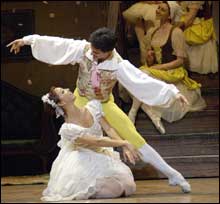 La Fille Mal Gardée (1789) leads off Cyril Beaumont’s indispensable 1000-page reference to the first 150 years of European ballet. Like many classic works that followed it, La Fille survived till Beaumont’s time by way of successive reworkings, each preserving elements of previous productions and inserting new ideas. Beaumont’s 1938 libretto sounds quite authentic, though no one by that time could have known exactly what the original Jean Dauberval ballet looked like.
La Fille Mal Gardée (1789) leads off Cyril Beaumont’s indispensable 1000-page reference to the first 150 years of European ballet. Like many classic works that followed it, La Fille survived till Beaumont’s time by way of successive reworkings, each preserving elements of previous productions and inserting new ideas. Beaumont’s 1938 libretto sounds quite authentic, though no one by that time could have known exactly what the original Jean Dauberval ballet looked like.
In fact, the Fille we recognize now as the real thing is quite modern. Frederick Ashton choreographed it in 1960 for the Royal Ballet, and one of its greatest interpreters, Alexander Grant, supervised the staging that returned to Boston Ballet last week after a three-year absence.
Boston Ballet doesn’t maintain a repertory of standards except for The Nutcracker, but La Fille Mal Gardée deserves to be performed more consistently here. Despite Ashton’s Anglicized rendering of the French subject, the ballet retains its flavor as an early work. It predates the Imperial-period Swan Lake and Sleeping Beauty and the Romantic-era Giselle and La Sylphide. It’s a story of simple folk and simpletons, who’ve never seen a king or a princess, never imagined fairy godmothers or menacing trolls. They understand three things: work, money, and love.
This poses a very different performing situation, at least for an American ballet company in the 21st century. Today’s dancers know how to wear splendid costumes and behave nobly, with superb technique exemplifying social order. Ashton asks something else of them: they have to create a community that enjoys itself. The main characters scheme to protect their families and their property, but neither magic nor monarchy controls the outcome.
A prosperous widow wants to make an advantageous match for her daughter, despite the fact that the prospective groom is missing more than a few marbles. Lise stages a whole repertory of tricks to evade her mother’s beady eye and rendezvous with her boyfriend Colas. In the end, it’s the mother who unwittingly defeats the unsuitable betrothal by being overprotective. Lise and Colas get her blessing at last.
ADVERTISEMENT
 |
The corps of farmer friends form the usual lines and background framing for the principal dancers, but they also produce important group designs and circle-dance romps. They dance for one another and with one another, not solely for the audience. Ashton’s ingenious choreography requires real cooperation.
The men dance around in a ring, bonking sticks together in precise rhythm. The women construct pinwheels, geometrics, and a pony cart with pink satin ribbons. They all celebrate around a Maypole, weaving a mesh at the top of the pole with the ribbons they hold. Four women back up the Widow Simone’s clog dance with a collective call-and-response pattern. By the time they all rollick away singing at the end, you’re convinced they must have been having as much fun as you have for the past two hours.
The other part of what makes Fille a challenge is the character work, and here I thought things were less believable. Most of the principals in the two casts I saw seemed to be working with studied eccentricity but little through-relationship to the plot. As Lise, Lorna Feijóo fired off a battery of expressions as formidable as her dancing, but she overpowered Nelson Madrigal, her Colas, in both categories. Misa Kuranaga mustered one charming smile after another but never appeared to be in love with Reyneris Reyes.
Christopher Budzynski played the drag role of the Widow Simone more modestly than Viktor Plotnikov, but neither one of them seemed to have decided whether he was playing a mean social climber or a softie. And both Joel Prouty and Jared Redick, as Alain the nitwit suitor, danced with fabulous spirit and extreme mugging. It’s possible to play all these characters for their flaws and their faux pas, but what makes La Fille Mal Gardée endearing is how sympathetic they can be too.